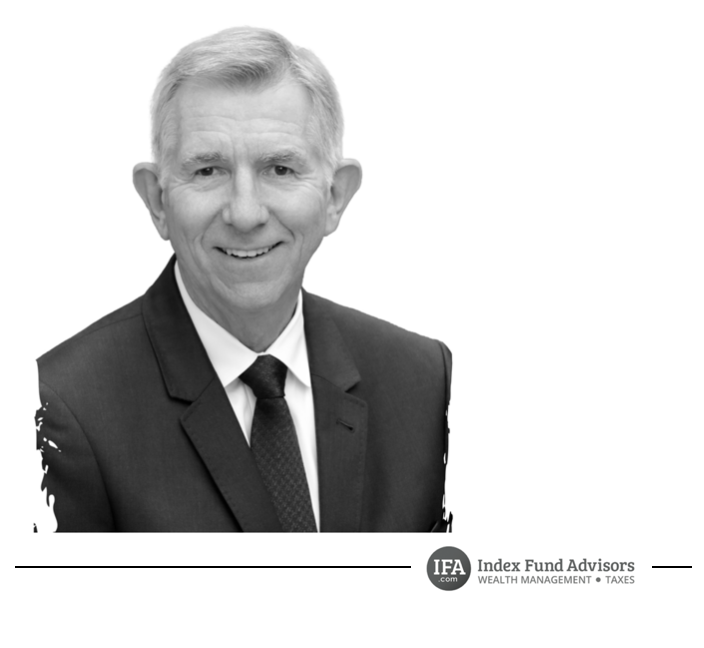By: Mark Hebner
CEO and Founder
INDEX FUND ADVISORS, INC
In late 1998 I was contacted by a recently widowed friend. She asked if I would accompany her to her investment advisors to interpret what they were telling her. She had been very confused in previous meetings where they tried to explain their investing strategies.
I agreed to her request, but then realized I better read up on investing so I would be well versed to make the translations. I visited the local Barnes & Noble and bought 22 books on investing. That was the beginning of what is now a 2,584-book library of financial books going all the way back to a book titled A Way to Wealth from 1648.
As I read through my initial purchase of books, I was shocked to discover that both professional and individual investors weren’t beating the market, the market was beating them. How could this be? How could mutual fund managers charge billions of dollars to beat their respective benchmarks when the only winners were those who just got lucky! This meant that no managers are “expected” to beat their appropriate benchmarks in the future!
The answer was hidden away in academic research about markets that started in 1900 and culminated in the late 1960s. Virtually no firms in the financial industry wanted to share this information because it would destroy their business model, which was based on investors trading securities. There are many opportunities for brokers to earn fees on trading and if investors decided to become buy and hold investors instead, the whole industry would have to change their revenue models.
Trading is the service offered by most of the securities industry for either a fee or a share of the trading price. On the other hand, registered investment advisors typically charge a percentage of assets under their management and therefore don’t rely on trading as a source of revenue.
After I finished my research, I realized that most of the industry was not maximizing the expected returns for their clients and therefore doing them a tremendous disservice.
My moonshot was to try to fix a broken industry and to do so utilizing an online investment education and offering a wealth management service that was fee based and utilized a passive management approach, as opposed to an active management approach.
I am a scientist by training and more specifically a Nuclear Pharmacist. So, my first inclination was to look for evidence and data to support my education. In fact, today this approach to investing is referred to as evidenced-based investing.
For the 2 years prior to my discoveries about index funds and passive investing, I had been an angel investor in several internet start-up companies, and I learned what was working in new dot com companies and about the interactivity of software tools like flash. Flash would allow me to create charts and graphs that would be dynamic and provide buttons that would change time periods and the display of moving data depending on options selected. It was a game changer for the visualization of large data sets and that was exactly what I needed to educate investors about the history and benefits of passive investing. But I was told by just about everyone that there was no way that people would trust their money to an online investment advisor. Instead, they wanted a face-to-face meeting because money is so personal.
But way back in 1999, I thought if I could do a Zoom like video conference utilizing Microsoft’s Netmeeting, I could show them my face and make it personal enough. Also, I planned to provide them such a high-quality investor education that they would develop an online trust for me and my firm. The video conferencing didn’t work until recently because the prospective clients did not have the technology to do it, but the online education did. Slow but sure we started receiving emails and calls from people who were blown away with our educational content and felt safe hiring us to manage their wealth.
Index Fund Advisors, Inc. started in March 1999 and by year end we had about $5 million in assets under management (AUM). About 23 years later we ended 2021 with $5 Billion in assets under management and 50 employees. I developed a survey that identifies each person’s risk capacity and directs them to a portfolio of index funds that has a matched risk exposure. I published my book in 2005 and have made 8 revisions since then. I then utilized the book as the basis for a script to make a documentary film. I also developed a series of indexes and index portfolios and took the data all the way back to 1928. This hypothetical back tested performance data provided risks and returns that was useful for investors and still are not available anywhere on the internet. Our website, ifa.com, is a cornucopia of knowledge about how markets work and how investors can maximize their expected returns given a certain level of risk.
My moonshot turned out to be a very long shot, but with lots of hard work, money, passion, creativity, and relentless persistence I was able to pull it off. Not many people encouraged me along the way. I had to rely mostly on my own entrepreneurial instincts that these Nobel Prize winning ideas would revolutionize the way people invest and that I, with a team of dedicated employees, had the skills and determination to pull off a nearly impossible achievement.
My mission is to change the way the world invests and every day I get a little closer to my goal.




